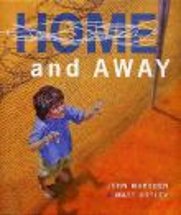Home and Away by John Marsden and Matt Ottley

Hachette, 2008.
ISBN 978073441056 6
Picture book, unpaged
(Ages: middle school to adult) The irony of the title will have
immediate appeal as readers recognize that the TV show of the same
name, with its emphasis on dysfunctional families is far removed from
the story unfolding before them. This book will shock; it will draw
kids in with its take on home and what that means. Not the frippery of
the television show of the same name, but a no holds barred look at
what it means when you and your home are separated, irretrievably.
Told in diary format, the narrator tells of the days following an
invasion and how it affects the family. With little detail, the family
is introduced in the first four pages, then the fifth page, April 27,
with the deep red colour of blood reflected through the aquarium, war
begins. Over the next four pages, the war is described, again sparely,
but the childlike illustrations mirror the horror of what is happening.
By August 29, rations are being handed out to the homeless, and on
September 16, the stark realistic illustration shows the scared and
undernourished family sitting by a candle, talking about what to do.
All around is black, the features of the family stand out in bleak
contrast. The alternate page illustrations depicting a child's drawings
underscore the brutality of what is happening, and the diary written on
scrap pieces of paper, reiterates the transitory nature of their lives.
What a time could be had in a class when this book is teamed with Shaun
Tan's, The Arrival, Mahtab's story by Libby Gleeson, Soraya
byRosanne
Hawke and Boy overboard by Morris Gleitzman among others. All
point to
the differences between our students and our safe lives, with kids
elsewhere, those who have no home. Tomorrow when the war began and its
sequels, all gained credibility because they put Australian kids into
the shoes of having to fight for their home, and this carries the same
theme. The picture of the bombed Sydney Harbour Bridge, the possum on
the road, point to the story being set in Australia, and so engenders
empathy from the readers, as the usual story of refugees is turned on
its head.
The statistical evidence, that one in 7 of the world's population is
homeless is hard to ignore, and Marsden and Ottley have made that
statistic as close to home as they possibly can.
Fran Knight